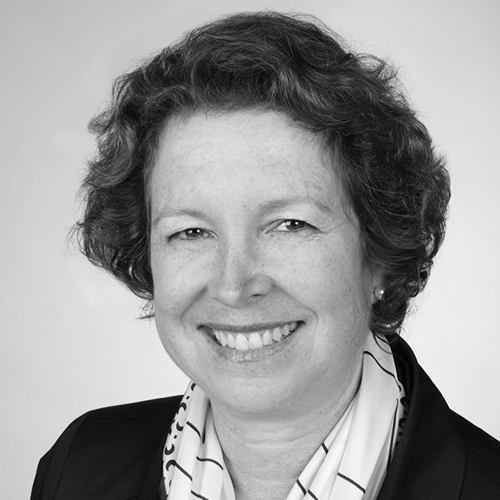Understanding cultural differences and encouraging people to celebrate and benefit from them is important to Gail Sharps Myers.
She moved to the United States from Jamaica when she was five years old. Her father was a military man, so the family moved all over the country. “I learned how to get along with lots of different people and adapt to different situations,” she explains.
This provided good training for the seven years Myers spent as an associate focusing on corporate transactions, securities, and mergers and acquisitions (M&A). “In the M&A world, you’re often helping companies figure out how best to combine cultures while retaining their individual strengths and values,” she says.
She loved the work, but after she had her first child, she accepted a job as an assistant general counsel at US Foods because she thought an in-house position would give her work-life balance. “Law firm lawyers tend to have a bit of a misconception about in-house demands,” she says. “There really isn’t less work, but you do have more control over when
you do it.”
Ten years later and after being promoted numerous times, she received an offer from Snyder’s-Lance, the second largest salty snack maker in the United States. “US Foods was on the brink of being acquired by Sysco—a deal that was ultimately scuttled by the Federal Trade Commission—and my role was going to change,” she says. “Snyder’s-Lance was offering me the chance to move into the general counsel position and lead my own team, develop compliance and government relations into stand-alone departments, have a seat at the executive table, and be part of an energetic growth trajectory.”
At the time, Snyder’s-Lance used more than twenty outside counsel firms. Including firms that handled specific international markets, the company used more than sixty. Myers eventually wants to have no more than five firms handling the company’s domestic matters, so she launched a request for proposal (RFP) program at the end of 2015. “This is part of the culture I hope to establish—one that produces greater efficiency and closer communication with our outside firms and enables us to choose them based on a clearer set of criteria,” she says. The RFP questionnaire she created asks firms to assess their attorneys’ ability to serve the company’s needs across locations and various subject matters; the reputation of the firm, individual attorneys, and practice areas; alternative fee arrangements; and each firm’s commitment to diversity.
Myers says the last point is key. “I want to know how a firm measures diversity and inclusion and what its current staffing looks like,” she says. “And I’m not just talking about gender and ethnicity. I want to see how they integrate people with different backgrounds, beliefs, sexual orientations. Firms need to be encouraged to do the right thing and cast a net as broadly as they can to increase diversity.
“I also want to know what they are doing to retain people,” she continues. “We know it isn’t just who you hire, but how you engage, support, and promote them. For instance, do they have a mentorship program that encourages diverse attorneys? Are leaders spending time with junior attorneys and providing them with opportunities to learn how to do things, including effective client management?”
“Firms need to be encouraged to do the right thing and cast a net as broadly as they can to increase diversity.”
Management doesn’t happen only within the walls of a firm or company, though. Myers believes employees should be encouraged to spend time together outside of the office, which she takes seriously at Snyder’s-Lance. “People tend to let down their guard and share personal sides of themselves in casual social situations,” she says. “I take my team to lunch and dinner; we go off-site for strategic planning sessions. We ‘play’ together. You’d be surprised how relaxed people can get in a bowling alley. I even had an event at my home last year. Everyone was encouraged to bring their families, and I included people from throughout the company. I’ve never believed that you have to be friends with everyone you work with, but you do need to have mutual respect. To help make that happen, managers need to provide people with ways to get to know each other.”
In addition to diversity and management development, fee flexibility is a criterion that Myers assesses critically. “One of the more interesting proposals we received was a blended rate,” she says. “Rather than giving us one rate for partners and another for associates, this firm suggested a flat rate for using any attorney across all subject matter areas. I’ve been involved in this kind of RFP process three different times, and this is the first time I’ve seen this kind of fee proposal. It reflects a collaborative culture, which is something we’re definitely looking for.”
Outside counsel recently became crucial to Myers’s work. Snyder’s-Lance acquired Diamond Foods, and the deal was finalized in February 2016. The acquisition represents the merger of three one-hundred-year-old companies.
“We have an incredible opportunity here to influence the cultural journey of the combined company,” says Myers. “Each has a loyal following and well-loved products. While not forgetting their individual heritages, we are now tasked with creating a new common culture, which is a very exciting proposition.”
To make the merger run as smoothly as possible, the company established an integration management office and supporting team that held weekly meetings and produced master plans covering days one, one hundred, and beyond.
The plans described what would happen during the first one hundred days of the integration and after them. “These were extremely detailed plans to ensure there would be no interruption of our business,” explains Myers. “For instance, if the companies were operating on different information technology (IT) platforms, the IT manager had to document how they were going to transition everyone to the same platform and exactly when that was going to happen. We didn’t want any surprises. Another challenge is that people and companies tend to reflect their locations,” Myers adds. “In 2010, when Snyder’s and Lance merged, we had to blend Snyder’s corporate team in Hanover, Maryland, with Lance’s corporate team in Charlotte, North Carolina. Now we have a third location, since Diamond’s corporate office was in San Francisco, California.”
The internal legal team, outside firms, and every department at Snyder’s-Lance were, and continue to be, part of the successful acquisition and merging of cultures.
“This is one of the aspects of mergers you don’t hear much about,” she says. “It takes a lot of concerted effort to make sure everything runs smoothly, no one feels slighted, and the ultimate combination benefits all parties—or as many as possible. Cultural integration, especially involving big, distinguished companies, requires constant, assiduous attention.”
GENDER DIVERSITY: BY THE NUMBERS
7.5%
of partners at US law firms identify as an ethnic minority
22%
of law firm associates identify as an ethnic minority
1/3
of legal professionals are women
1/5
of law firm partners, Fortune 500 general counsel, and law school deans are women
17%
of equity partners at US law firms are women
7
of the 100 largest firms have a woman chairman or managing partner
Sources: National Association of Law Placement Bulletin, The Washington Post

